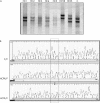Identification of three novel RB1 mutations in Brazilian patients with retinoblastoma by "exon by exon" PCR mediated SSCP analysis
- PMID: 15166261
- PMCID: PMC1770321
- DOI: 10.1136/jcp.2003.014423
Identification of three novel RB1 mutations in Brazilian patients with retinoblastoma by "exon by exon" PCR mediated SSCP analysis
Abstract
Aims: To carry out a retrospective study, screening for mutations of the entire coding region of RB1 and adjacent intronic regions in patients with retinoblastoma.
Methods: Mutation screening in DNA extracts of formalin fixed, paraffin wax embedded tissues of 28 patients using combined "exon by exon" polymerase chain reaction mediated single strand conformational polymorphism analysis, followed by DNA sequencing.
Results: Eleven mutations were found in 10 patients. Ten mutations consisted of single base substitutions; 10 were localised in exonic regions (eight nonsense, one missense, and one frameshift) and another one in the intron-exon splicing region. Three novel mutations were identified: a 2 bp insertion in exon 2 (g.5506-5507insAG, R73fsX77), a G to A transition affecting the last invariant nucleotide of intron 13 (g.76429G>A), and a T to C transition in exon 20 (g.156795T>C, L688P). In addition, eight C to T transitions, resulting in stop codons, were found in five different CGA codons (g.64348C>T, g.76430C>T, g.78238C>T, g.78250C>T, and g.150037C>T). Although specific mutation hotspots have not been identified in the literature, eight of the 11 mutations occurred in CGA codons and seven fell within the E1A binding domains (codons 393-572 and 646-772), whereas five were of both types-in CGA codons within E1A binding domains.
Conclusions: CGA codons and E1A binding domains are apparently more frequent mutational targets and should be initially screened in patients with retinoblastoma. Paraffin wax embedded samples proved to be valuable sources of DNA for retrospective studies, providing useful information for genetic counselling.
Figures


Similar articles
-
A molecular study of first and second RB1 mutational hits in retinoblastoma patients.Cancer Genet Cytogenet. 2006 May;167(1):43-6. doi: 10.1016/j.cancergencyto.2005.08.017. Cancer Genet Cytogenet. 2006. PMID: 16682285
-
Two independent RB1-inactivating mutations in peripheral blood DNA of a hereditary retinoblastoma patient.Genes Chromosomes Cancer. 2004 Jul;40(3):271-5. doi: 10.1002/gcc.20042. Genes Chromosomes Cancer. 2004. PMID: 15139006
-
Identification of four novel RB1 germline mutations in Korean retinoblastoma patients.Hum Mutat. 2001 Sep;18(3):252. doi: 10.1002/humu.1184. Hum Mutat. 2001. PMID: 11524739
-
[From gene to disease; retinoblastoma and the RB1 gene].Ned Tijdschr Geneeskd. 2001 Jun 30;145(26):1245-7. Ned Tijdschr Geneeskd. 2001. PMID: 11455690 Review. Dutch.
-
Retinoblastoma: From genes to patient care.Eur J Med Genet. 2023 Jan;66(1):104674. doi: 10.1016/j.ejmg.2022.104674. Epub 2022 Dec 5. Eur J Med Genet. 2023. PMID: 36470558 Review.
Cited by
-
A study on p53 gene alterations in esophageal squamous cell carcinoma and their correlation to common dietary risk factors among population of the Kashmir valley.World J Gastroenterol. 2006 Jul 7;12(25):4033-7. doi: 10.3748/wjg.v12.i25.4033. World J Gastroenterol. 2006. PMID: 16810754 Free PMC article.
-
Genetic screening in patients with Retinoblastoma in Israel.Fam Cancer. 2015 Sep;14(3):471-80. doi: 10.1007/s10689-015-9794-z. Fam Cancer. 2015. PMID: 25754945
-
Advantages of a next generation sequencing targeted approach for the molecular diagnosis of retinoblastoma.BMC Cancer. 2015 Nov 4;15:841. doi: 10.1186/s12885-015-1854-0. BMC Cancer. 2015. PMID: 26530098 Free PMC article.
-
Correlation of p53 over-expression and alteration in p53 gene detected by polymerase chain reaction-single strand conformation polymorphism in adenocarcinoma of gastric cancer patients from India.World J Gastroenterol. 2009 Mar 21;15(11):1381-7. doi: 10.3748/wjg.15.1381. World J Gastroenterol. 2009. PMID: 19294769 Free PMC article.
References
-
- Schultz KR, Ranade S, Neglia JP, et al. An increased relative frequency of retinoblastoma at a rural regional referral hospital in Miraj, Maharashtra, India. Cancer 1993;72:282–6. - PubMed
-
- Vogel F. Genetics of retinoblastoma. Hum Genet 1979;52:1–54. - PubMed
-
- Gallie BL, Moore A. Retinoblastoma. In: Taylor D, ed. Paediatric ophthalmology. Oxford: Blackwell Scientific, 1997:519–53.
-
- Yandell DW, Campbell TA, Dayton SH, et al. Oncogenic point mutations in the human retinoblastoma gene: their application to genetic counseling. N Engl J Med 1989;321:1689–95. - PubMed
Publication types
MeSH terms
Substances
LinkOut - more resources
Full Text Sources
Research Materials
Miscellaneous
